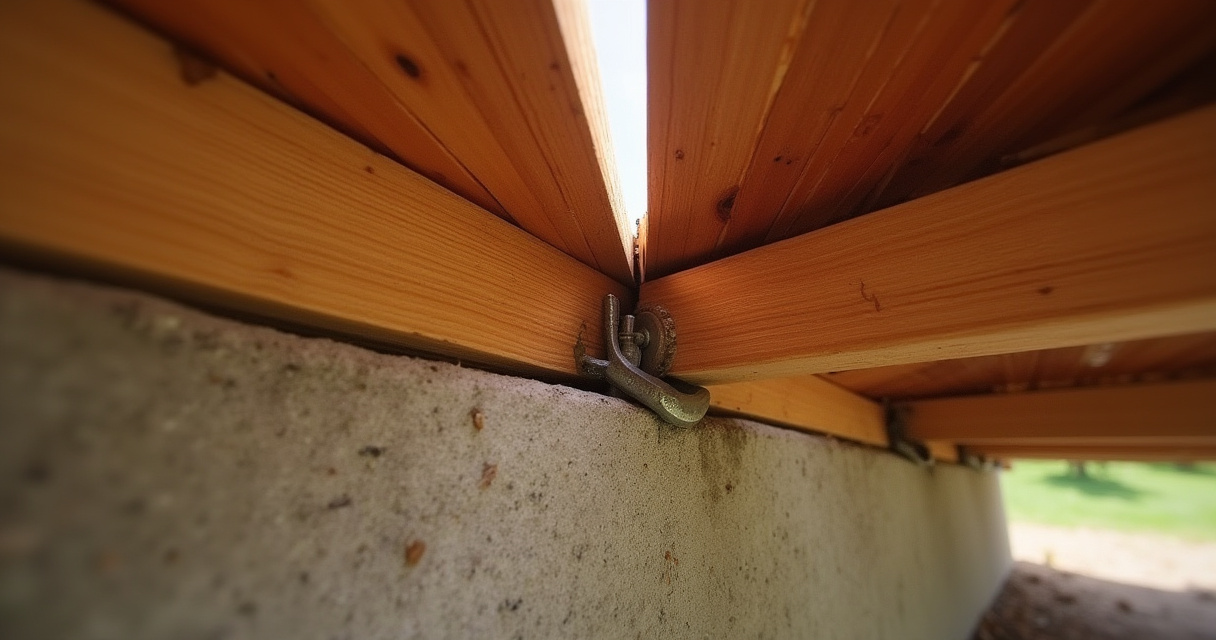Picture this: You’re walking out onto your deck with a cup of coffee. The wood under your feet is warm, protected by a non-toxic sealant that doesn’t harm the soil below. Your furniture is made from recycled milk jugs, yet it’s so comfortable and stylish you’d swear it was high-end wood. Bees are buzzing around native flowers spilling from planters, and the only light you’ll need tonight comes from solar-powered string lights that will cast a warm, magical glow. This isn’t just a deck; it’s a sanctuary. It’s a space that feels good for you and does good for the planet.
As someone who bridges the world of environmental science and design, my biggest pet peeve is the idea that an eco-conscious home means compromising on style. It’s the opposite. True, lasting beauty comes from making thoughtful choices—choosing materials that endure, plants that support local life, and designs that work with nature, not against it. A disposable, plastic-heavy deck that needs replacing in five years isn’t just a bad investment for you; it’s a terrible one for the Earth. So let’s talk about how to create an outdoor space that’s both gorgeous and genuinely sustainable. I’m going to walk you through the real-world choices that matter, cutting through the greenwashing and corporate speak.
Foundational Planning & Essential Considerations (Part 1)
Before you even think about throw pillows or planters, we have to talk about the bones of your space. A truly sustainable deck is one that’s built to last, maximizing its lifespan and minimizing the need for wasteful replacements. Getting these foundational steps right is the single most important thing you can do to reduce your deck’s environmental footprint over its lifetime. It’s not the glamorous part, but I promise, it’s the most impactful.
1. Assess Your Deck’s Structural Health Before Decorating
The most unsustainable thing you can do is decorate a deck that’s about to fail. I once consulted for a family who had spent a fortune on beautiful recycled furniture and organic cushions, only to find their ledger board—the piece connecting the deck to the house—was severely rotted. They had to tear everything out, and the “sustainable” furniture had to be moved while a hugely resource-intensive repair took place. Don’t let this be you. Before you buy a single thing, get down and dirty. Shake the railings. Are they wobbly? Poke at the support posts with a screwdriver. Does the wood feel soft or spongy? Check for any signs of rot, insect damage, or loose connections.
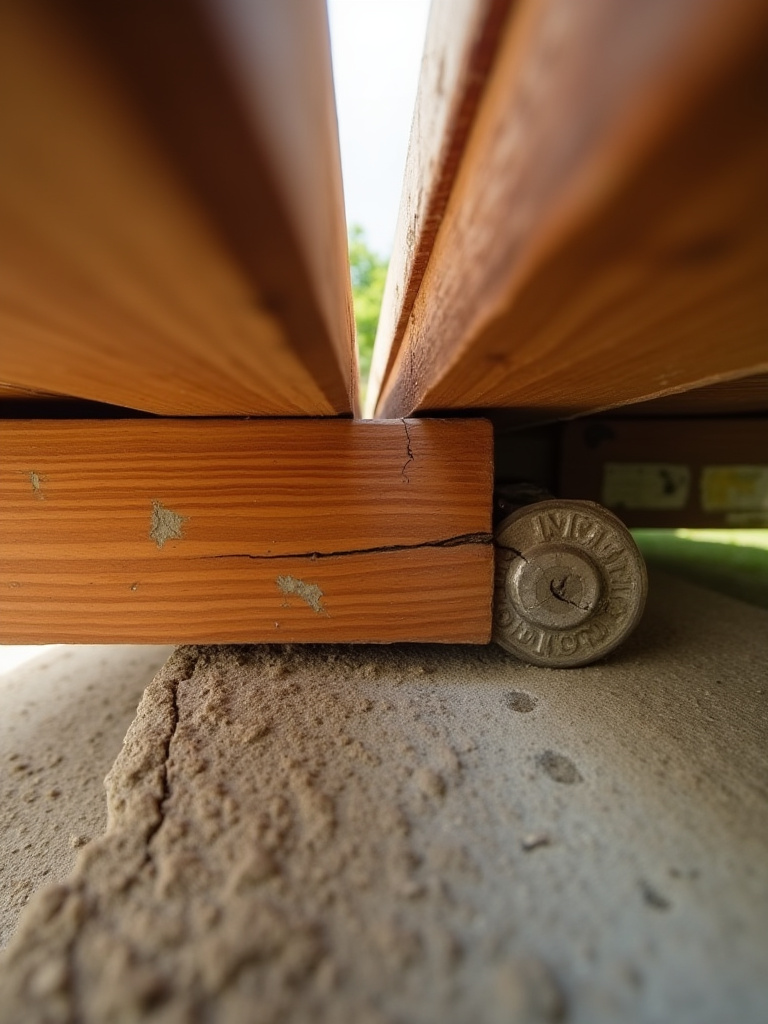
This isn’t just about safety, which is paramount; it’s about resource management. A deck that needs a full replacement means old materials in a landfill and new resources consumed. A simple, proactive repair now—swapping out a few boards or reinforcing a post—can extend the life of your existing structure for a decade or more. That’s a massive environmental win. A healthy foundation means your beautiful, eco-conscious decor has a lasting home.
With a safe and sound structure confirmed, we can now dream a little bigger and start thinking about the overall vibe and function of your future oasis.
2. Define Your Deck’s Ambiance with a Cohesive Style Theme
You wouldn’t just throw random furniture into your living room, so why do it on your deck? Defining a theme isn’t about being rigid; it’s about making conscious choices. Without a plan, you end up with a collection of impulsive buys—a tiki torch from a clearance sale, a metal bistro set that doesn’t match the rattan lounger. This approach leads to waste because nothing ever feels quite right, and you’re constantly looking to replace things. A cohesive theme acts as your filter, helping you buy less, but buy better. Think of your deck as an extension of your indoor aesthetic, guided by nature. Are you “Coastal Naturalist” with driftwood tones, seagrass textures, and hardy dune grasses? Or maybe “Biophilic Modern” with clean lines, black metal accents, and lush, overflowing greenery?
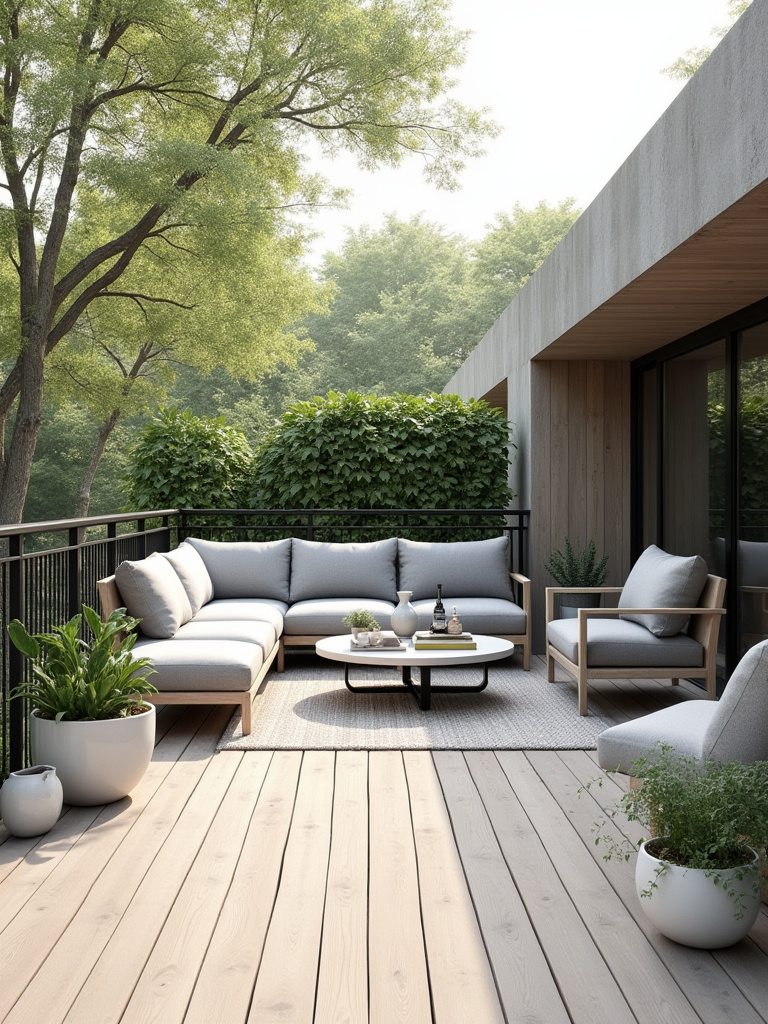
Once you have your theme, every choice becomes simpler and more intentional. That brightly colored plastic planter won’t fit your “Earthy Minimalist” vibe, so you skip it and find a beautiful terracotta pot from a local potter instead. This discipline prevents you from acquiring items that will eventually feel like clutter and end up in a garage sale or, worse, the trash. It’s about creating a space that feels so complete and harmonious that you won’t feel the constant urge to add or change things. That’s a core principle of sustainable design: love what you have, and make it last.
Thinking about your theme will naturally lead you to consider how you’ll actually use the space, which is our next critical step.
3. Map Out Functional Zones for Dining, Lounging, and Entertaining
Can we agree that the “one giant table in the middle of the deck” approach is broken? It’s inefficient and rarely reflects how we actually live. Zoning your deck into distinct areas—a small spot for morning coffee, a larger area for dining, a cozy corner for lounging—is the secret to making the space feel both larger and more functional. When a space serves multiple purposes well, you’re less likely to feel you need a bigger space, which is a sustainability win in itself. Proper zoning means every square foot is working for you, reducing the perceived need for more.
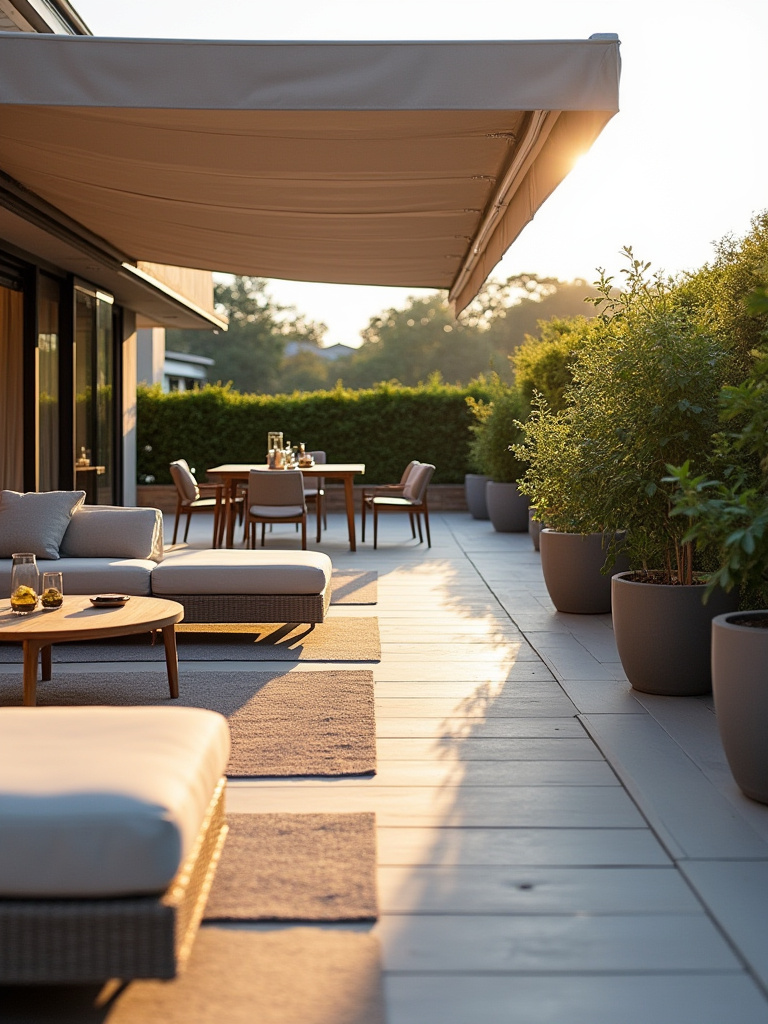
Think about the flow. Where is the path from the door to the grill? Where does the sun hit in the afternoon? Place your lounging zone in a spot that gets evening shade. A dining area might work best closer to the kitchen door. You can use an outdoor rug made from recycled plastic bottles to anchor your “living room” zone or a row of tall planters with native grasses to create a soft, natural barrier for your dining “room.” By designing for your actual lifestyle, you ensure the entire space gets used and loved, preventing it from becoming a glorified storage platform for a lonely grill.
Now that we’ve planned the layout, it’s crucial to consider the practical needs that make these zones functional after the sun goes down.
4. Strategically Integrate Power Sources for Lighting and Gadgets
Let’s get this out of the way: extension cords are ugly, unsafe, and unsustainable. A truly functional outdoor space needs thoughtfully integrated power, but we can do it smarter. Instead of thinking exclusively about hardwired, grid-tied electricity, prioritize low-impact solutions first. Is your main goal ambient lighting? High-quality solar-powered string lights and lanterns have become so good they can provide beautiful, warm light for hours, with zero energy cost and a minimal installation footprint. They’re the definition of working with nature.
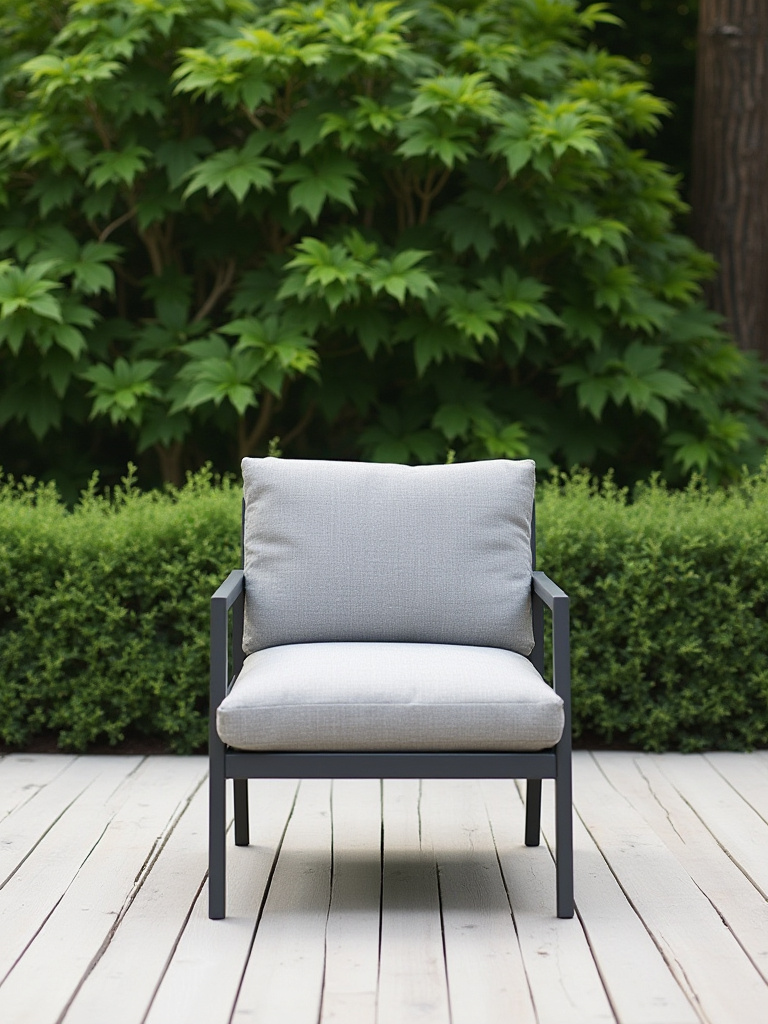
For tasks that do require more power, like a blender for outdoor parties or charging a speaker, consider having a licensed electrician install just one or two strategically placed GFCI outlets. Put them in discreet locations where they’ll serve the most purpose, perhaps near a dining or lounging zone. This is far more efficient than dotting the entire perimeter with outlets that will rarely get used. And for heating, skip the power-hungry options for now (we’ll get to that later) and think about a cozy fire pit. Planning for smart, minimal power usage from the beginning prevents costly, resource-intensive retrofits later on.
With the core planning in place, it’s time to address a key element that can make or break the feeling of your outdoor sanctuary: privacy.
Foundational Planning & Essential Considerations (Part 2)
We’ve laid the groundwork, but one crucial element often overlooked until it’s too late is how to make your deck feel like a secluded retreat. Creating a sense of privacy is what transforms a functional platform into a personal sanctuary where you can truly unwind, and doing it sustainably means looking to nature for our best solutions.
5. Optimize Privacy with Natural Barriers or Architectural Screens
Forget the cheap, plastic lattice from the big-box store that will get brittle and crack in a few years. The most beautiful and eco-friendly way to create privacy is with living, breathing screens. Planting a row of tall, native grasses in slender containers can create a gorgeous, semi-transparent barrier that sways in the wind. Installing a simple trellis and planting a fast-growing, non-invasive native vine creates a lush green wall that also provides a habitat for local birds and pollinators. You’re not just blocking a view; you’re building a tiny ecosystem.
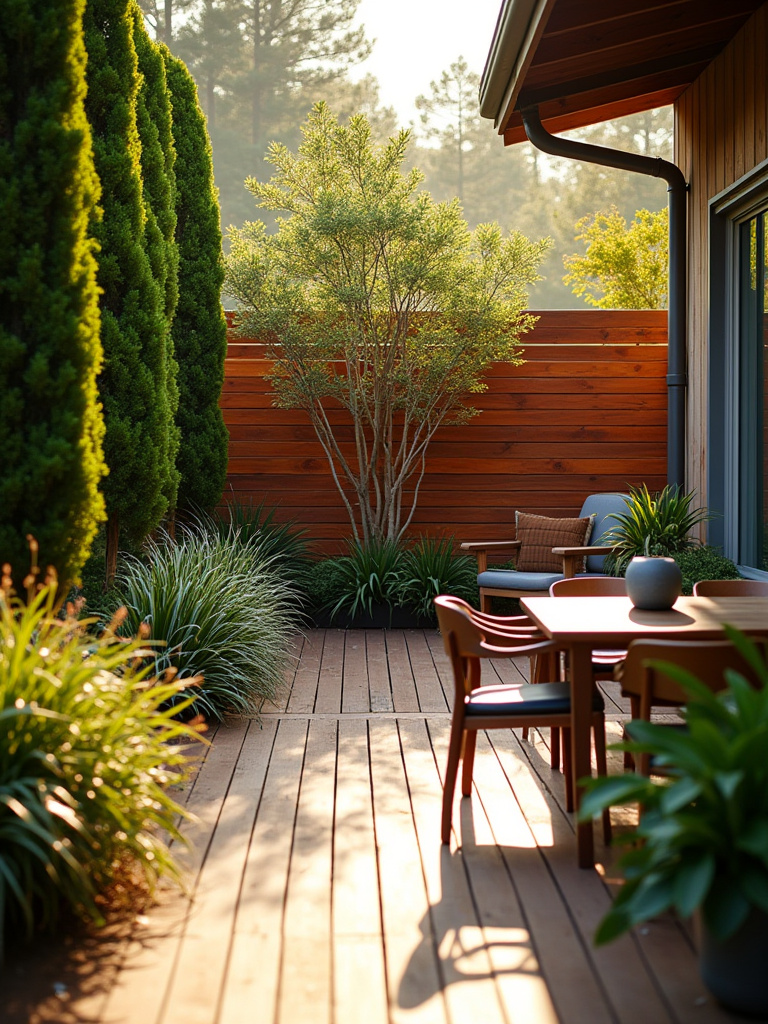
If a living wall isn’t feasible, look to architectural solutions made from sustainable or reclaimed materials. A screen made from salvaged wood or locally sourced cedar slats adds incredible warmth and texture. These natural materials age gracefully, developing a beautiful patina over time, unlike plastic which just… gets old. The goal is to create seclusion that feels integrated with the environment.
“A living wall does more than provide privacy; it cools the air around it, cleanses pollutants, and connects us back to the natural world. It’s an architectural feature that gives back.”
With your foundational planning complete, it’s time to furnish this beautiful, private, and well-designed space.
Core Furnishing & Functional Elements (Part 1)
Now for the fun part: filling your space with things that bring you comfort and joy. But this is where the modern plague of “fast furniture” often creeps in. Our goal here is to choose core pieces that are not only beautiful and functional but are also kind to the planet, designed to last for decades, not just a season or two.
6. Select Weather-Resistant Furniture for Lasting Comfort
I want to tell you a hard truth: that impossibly cheap resin chair set is not a bargain. It’s a future landfill item. It will fade, become brittle in the sun, and crack within a few years, forcing you to throw it away and buy another. This cycle of disposable outdoor furniture is a huge source of plastic waste. The most sustainable choice is to invest once in high-quality furniture that will last a lifetime. Look for materials like recycled high-density polyethylene (HDPE), which is made from things like milk jugs and shampoo bottles. It’s incredibly durable, comes in great colors, and diverts tons of plastic from landfills.
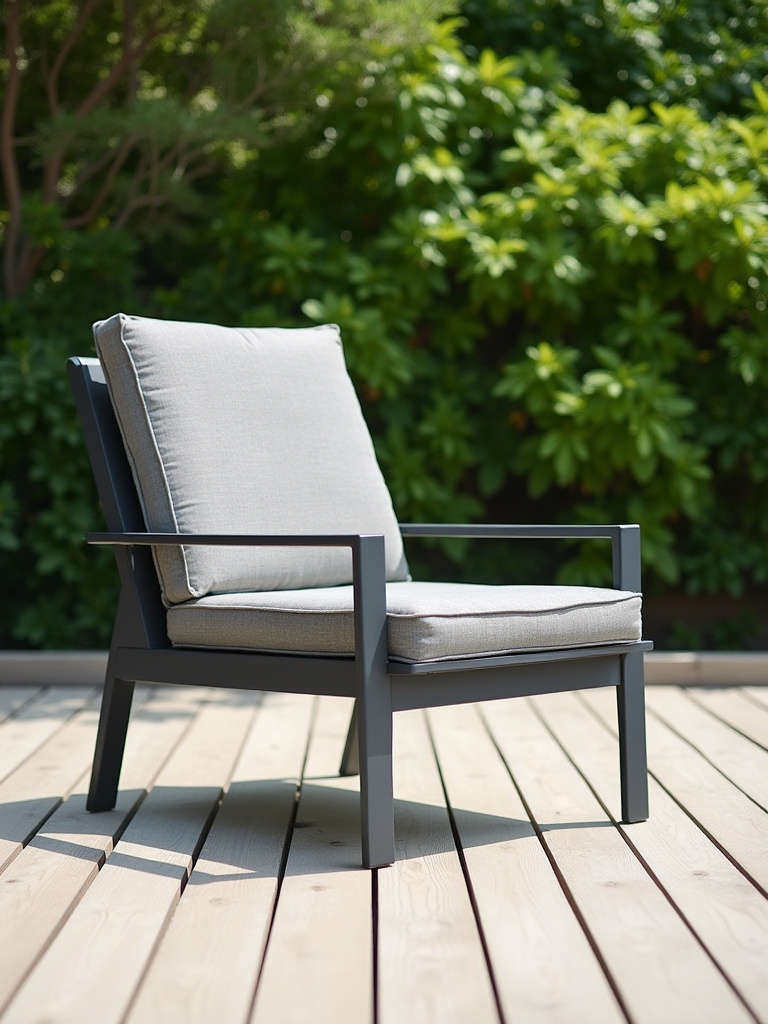
Other fantastic options include sustainably-harvested wood like FSC-certified teak or acacia, which naturally resist rot and insects, or powder-coated aluminum, which is lightweight, rust-proof, and infinitely recyclable. Yes, these options have a higher upfront cost. But when you divide that cost over the 20+ years they will last, they are far cheaper than replacing flimsy furniture every few seasons. It’s a shift in mindset: from temporary consumer to long-term caretaker of your belongings.
Once you have your foundational furniture, the next layer of comfort comes from under your feet.
7. Elevate Foot Traffic Zones with Durable Outdoor Rugs
An outdoor rug is the single fastest way to make a deck feel like a true “room.” It anchors the furniture, defines a zone, and adds a layer of comfort and color. But not all rugs are created equal. The most sustainable options are those made from recycled materials, specifically PET, which is a durable fiber made from recycled plastic bottles. It’s amazing to think you can be standing on a soft, stylish rug that used to be a few dozen water bottles. These rugs are incredibly durable, easy to clean, and resistant to mold and mildew.
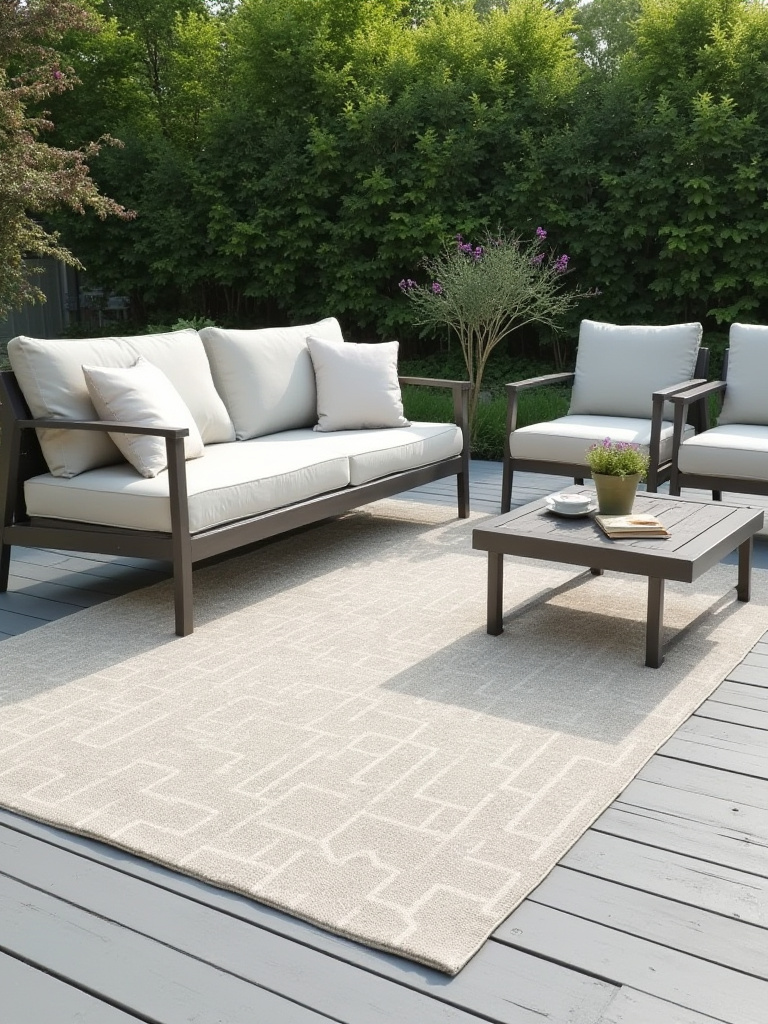
Beyond the material itself, a rug plays a protective role. It shields your deck boards from the constant scraping of chair legs and heavy foot traffic, and it protects the finish from UV damage. By preserving the surface of your deck, you are extending its lifespan, which, as we’ve discussed, is a huge sustainability win. Look for rugs that are certified for fair labor practices to ensure that your beautiful addition is also ethically produced.
With furniture and a rug in place, let’s look up and consider how to make the space comfortable on even the sunniest days.
8. Incorporate Overhead Shade Solutions for Sun Protection
Instead of a standard polyester umbrella that will fade and fray in a few seasons, think about more permanent and natural solutions for shade. A beautiful wooden pergola is a fantastic investment. You can leave it open for a modern look or, better yet, grow a deciduous native vine over it. In the summer, its leaves will create dense, cooling shade. In the winter, the bare vines will let the warming sunlight through. It’s a dynamic, living shade structure that works in harmony with the seasons.
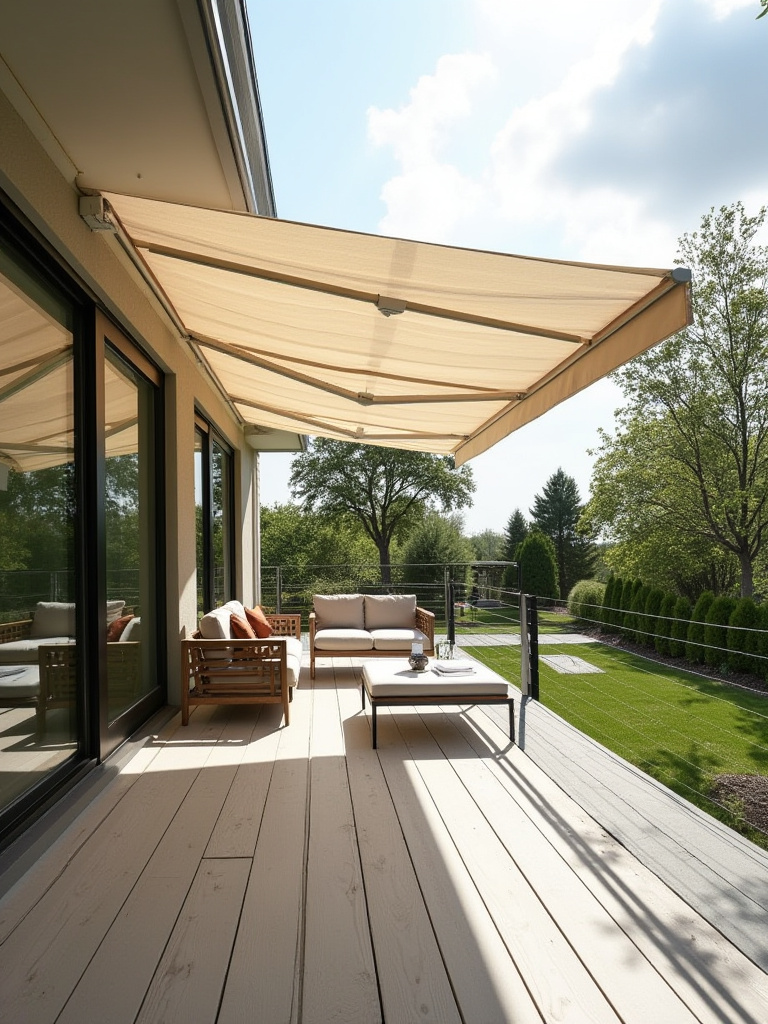
If you opt for a fabric solution like a shade sail or retractable awning, the material matters. Look for high-quality, solution-dyed acrylics. The color is part of the fiber itself, not just a surface dye, which means it’s incredibly resistant to fading. This longevity means you won’t be sending a faded, torn piece of fabric to the landfill in three years. A quality shade solution protects you, protects your furniture from fading, and can even help cool your house, reducing your reliance on air conditioning.
As you furnish your deck, you’ll inevitably accumulate accessories, which brings us to the crucial topic of keeping things tidy.
9. Choose Smart Storage Solutions to Minimize Clutter
Sustainable living is deeply connected to organization. When your cushions, gardening tools, and outdoor games have a dedicated home, they are protected from the elements and last longer. A pile of rain-soaked cushions will quickly develop mildew and end up in the trash. The same cushions, stored in a dry deck box, will serve you for years. Good storage is an act of preservation. Look for multi-functional pieces: a bench that doubles as a storage box, or a coffee table with a concealed compartment. This reduces the number of separate items you need to buy.
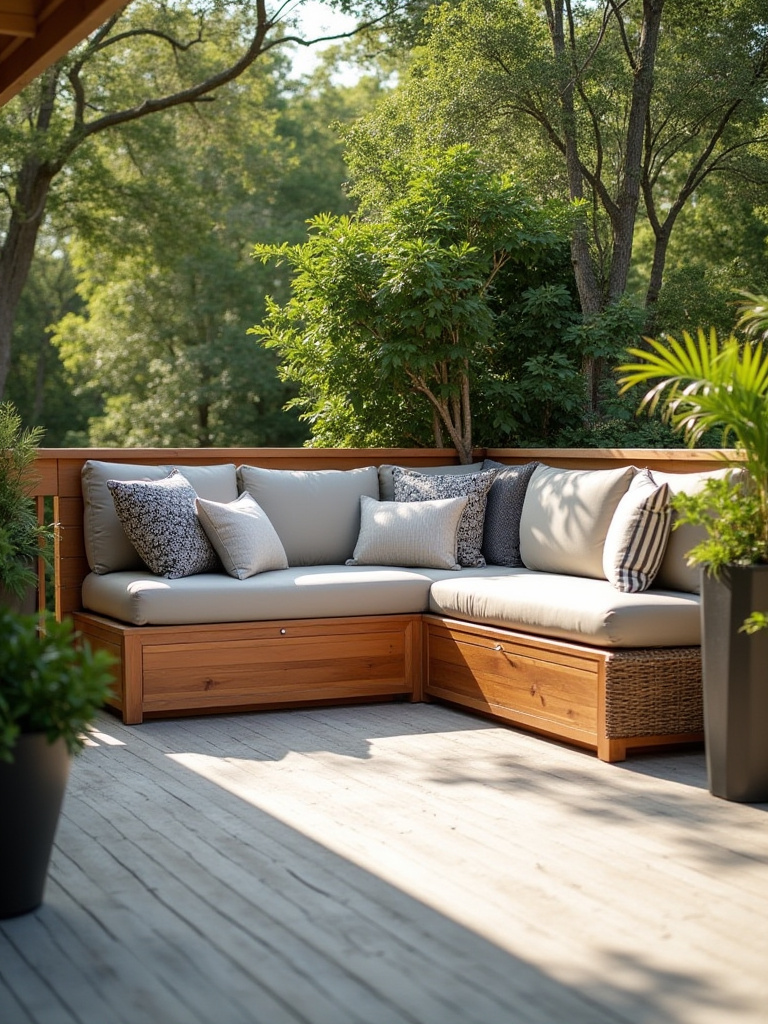
When choosing a deck box or cabinet, pay close attention to the material. Avoid the flimsy, single-walled plastic boxes that will warp and crack. Opt for high-quality, durable resin with UV inhibitors, or even better, a storage unit made from the same long-lasting, sustainably-sourced wood as your furniture. A well-built storage solution should be seen as another piece of permanent furniture, not a temporary, disposable container.
Now that we have the core elements of comfort covered, let’s infuse the space with life and greenery.
Core Furnishing & Functional Elements (Part 2)
We’ve built the foundation and added the core furniture. Now, it’s time to bring in the elements that make a space feel truly alive. This is where we layer in living greenery and think about how to extend the usability of our deck beyond just the warmest days, all while keeping our environmental impact low.
10. Integrate Vertical Gardening Elements for Greenery
When you have limited floor space, the only way to go is up! A vertical garden is a brilliant way to surround yourself with lush greenery without sacrificing a single square foot of lounging area. You can mount pocket planters on a wall to create a living tapestry of herbs, succulents, or ferns. A simple trellis can support climbing beans or flowering vines, providing both beauty and a potential harvest. Growing your own herbs—even just a small container of basil, mint, and rosemary—dramatically cuts down on the plastic packaging and food miles associated with store-bought herbs.
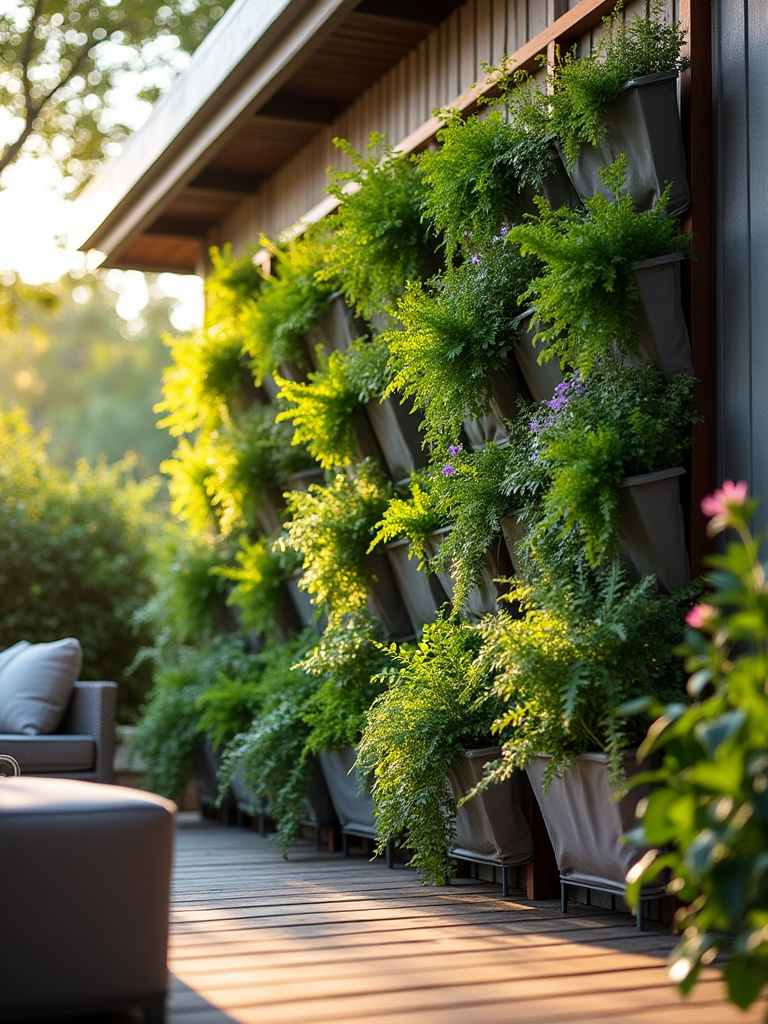
This isn’t just about aesthetics; it’s about creating a micro-habitat. Planting native, flowering species in your vertical garden provides a vital food source for local pollinators like bees and butterflies, whose populations are in decline. A wall covered in plants also has a cooling effect on the surrounding air, creating a more comfortable microclimate on your deck and even helping to insulate the adjacent wall of your house, potentially reducing cooling costs. It’s a design choice that is beautiful, functional, and actively beneficial to your local environment.
Bringing life to your deck with plants naturally leads to thinking about how to enjoy the space when the seasons change and the air gets a little cooler.
11. Create a Cozy Ambiance with Strategic Outdoor Heating
Let’s be honest: those tall, propane-powered “mushroom” heaters are an environmental disaster. They are incredibly inefficient, pumping most of their heat straight up into the atmosphere while guzzling fossil fuels. There are far smarter and more sustainable ways to stay warm. The best option is targeted, electric infrared heat. These heaters don’t warm the air; they warm objects (including you!). They use significantly less energy and can be mounted on a wall or ceiling, directing warmth exactly where you need it without waste.
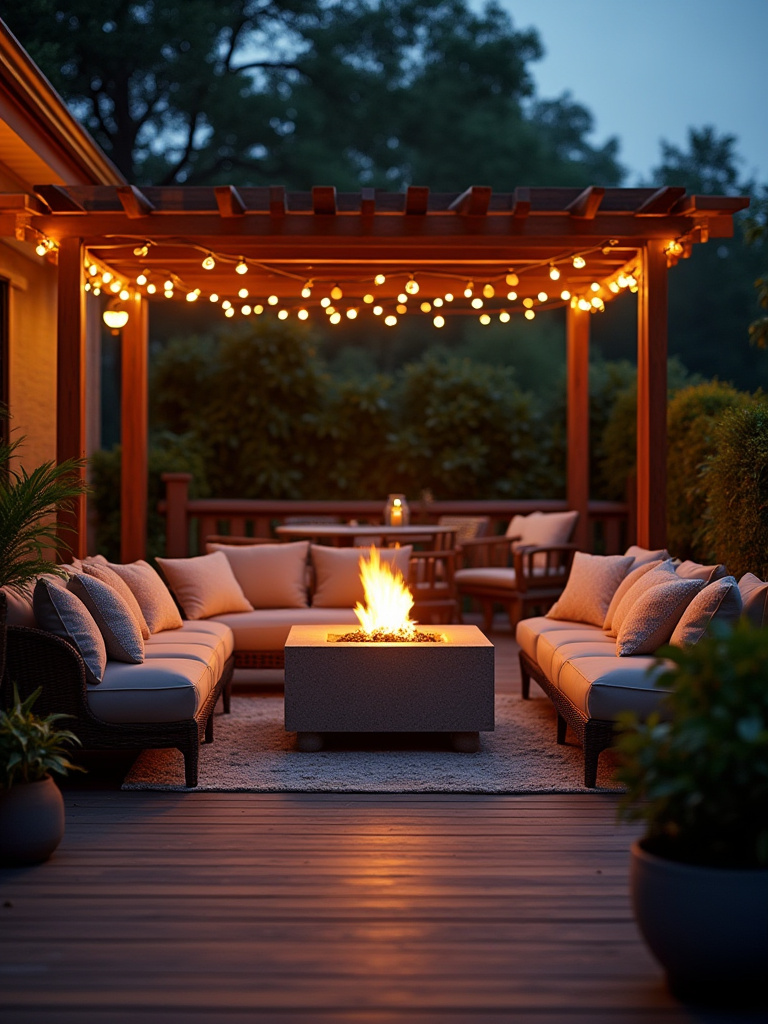
Another wonderful option is a modern, clean-burning fire pit or a chiminea. Look for models designed to maximize airflow, which results in less smoke and a more efficient burn. They can be fueled with sustainably-sourced firewood or even scrap wood from your own yard. The radiant heat from a real fire creates a primal sense of comfort and a natural gathering point, extending your deck’s usability deep into the fall and even on cool spring evenings, all without the massive carbon footprint of a propane heater.
With the functional elements in place, we can now turn our attention to the styling details that will make your deck uniquely yours.
Styling, Lighting & Decorative Enhancements (Part 1)
This is where the soul of your deck comes to life. We’re moving beyond the functional and into the realm of ambiance, mood, and personality. These are the layers that transform your well-designed space into a magical retreat, especially after the sun goes down. And of course, we’ll do it sustainably.
12. Brighten Evenings with Layered Outdoor Lighting Schemes
Great lighting design isn’t about blasting your deck with a single, harsh floodlight. It’s about creating layers of gentle, warm light that build atmosphere. And the best news? The most beautiful and sustainable way to do this is with solar power. Modern solar-powered string lights are fantastic; they cast a warm, inviting glow and cost absolutely nothing to run. You can weave them through the rafters of a pergola, drape them along a railing, or string them to a nearby tree. There are no wires, no bills, and no carbon emissions.
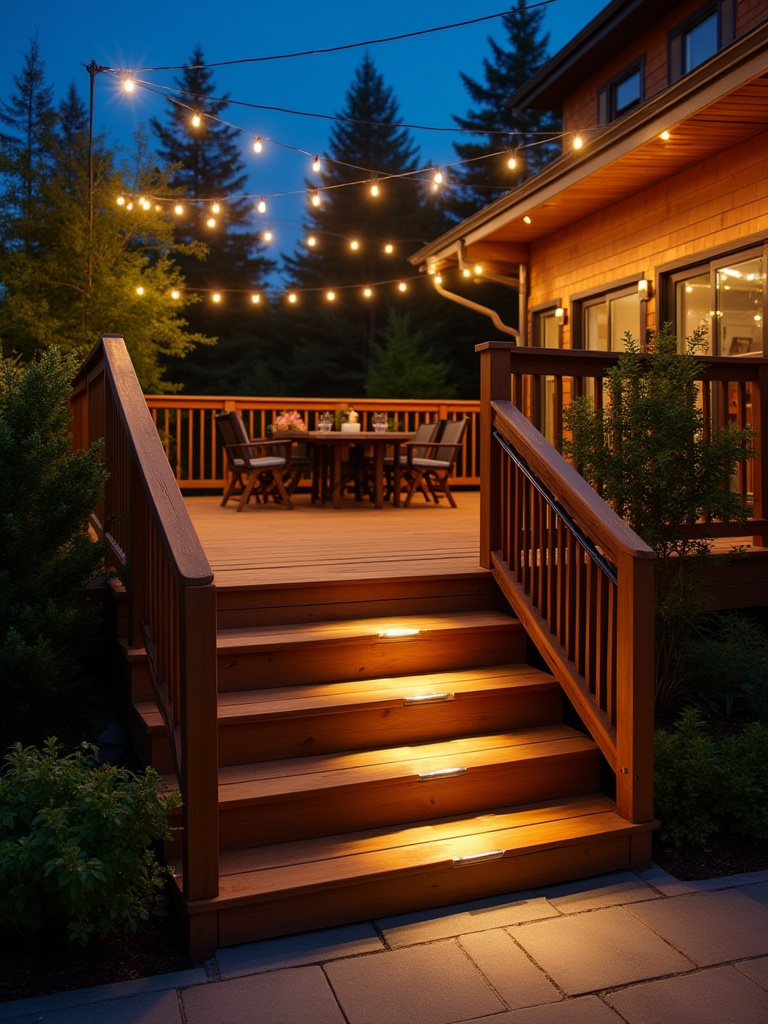
Supplement your ambient string lights with other solar options. Solar-powered lanterns can sit on a table or hang from a hook. Small, discreet solar spotlights can be used to “uplight” a beautiful planter or an interesting architectural feature. For pathways and stairs, where safety is key, consider low-voltage LED lighting. LEDs are incredibly energy-efficient and long-lasting, and a low-voltage system uses a fraction of the power of a standard line-voltage system. By combining these gentle sources, you create a dynamic, enchanting space that invites you to linger long after dark.
Light sets the stage, but the tactile elements of comfort are what make a space truly inviting.
13. Add Pops of Color with Weatherproof Throw Pillows and Cushions
Throw pillows are the jewelry of your outdoor room, but they can also be a source of waste if you choose the wrong materials. Avoid cheap polyester pillows that will fade in one season and feel rough against your skin. Instead, look for high-quality outdoor cushions made from solution-dyed acrylics. These fabrics are incredibly durable and fade-resistant, meaning they’ll look great for years. Or, even better, seek out brands that make outdoor textiles from recycled plastic bottles. These fabrics are surprisingly soft, vibrant, and divert a huge amount of plastic waste from our oceans and landfills.
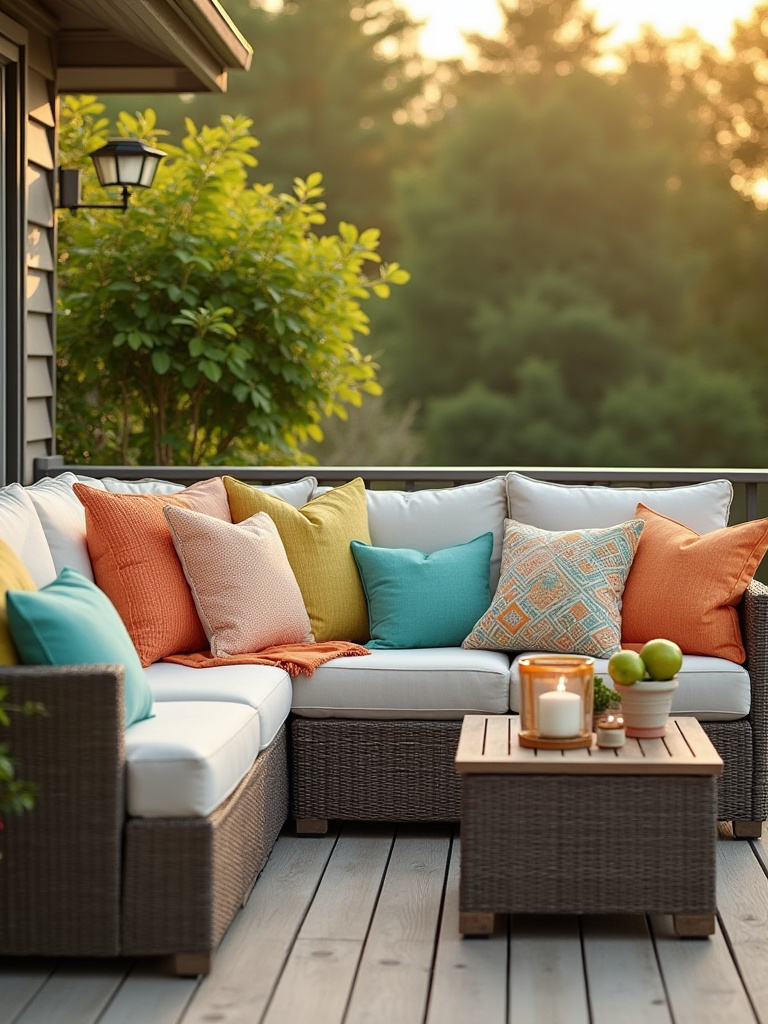
Think of your pillows and cushions as a “capsule collection.” Invest in a few high-quality, versatile pieces in colors and patterns you truly love, rather than a large collection of cheap, trendy items that you’ll want to replace next year. A good rule of thumb is to choose covers that are removable and machine-washable, which will extend their life even further. This is about choosing comfort that you can feel good about, both literally and ethically.
Comfort isn’t just physical; it’s also about surrounding yourself with things that express who you are.
14. Personalize Your Space with Unique Outdoor Art and Sculptures
Your deck is an extension of your home, so why not display art there? This doesn’t mean you need to buy an expensive bronze sculpture (unless you want to!). Think creatively and sustainably. A beautiful piece of driftwood found on a beach trip can become a stunning natural sculpture. A local artist who works with reclaimed metal could create a unique wall hanging. Visiting local craft fairs or artisan markets is a wonderful way to find one-of-a-kind pieces that support your local economy and haven’t been shipped across the globe.
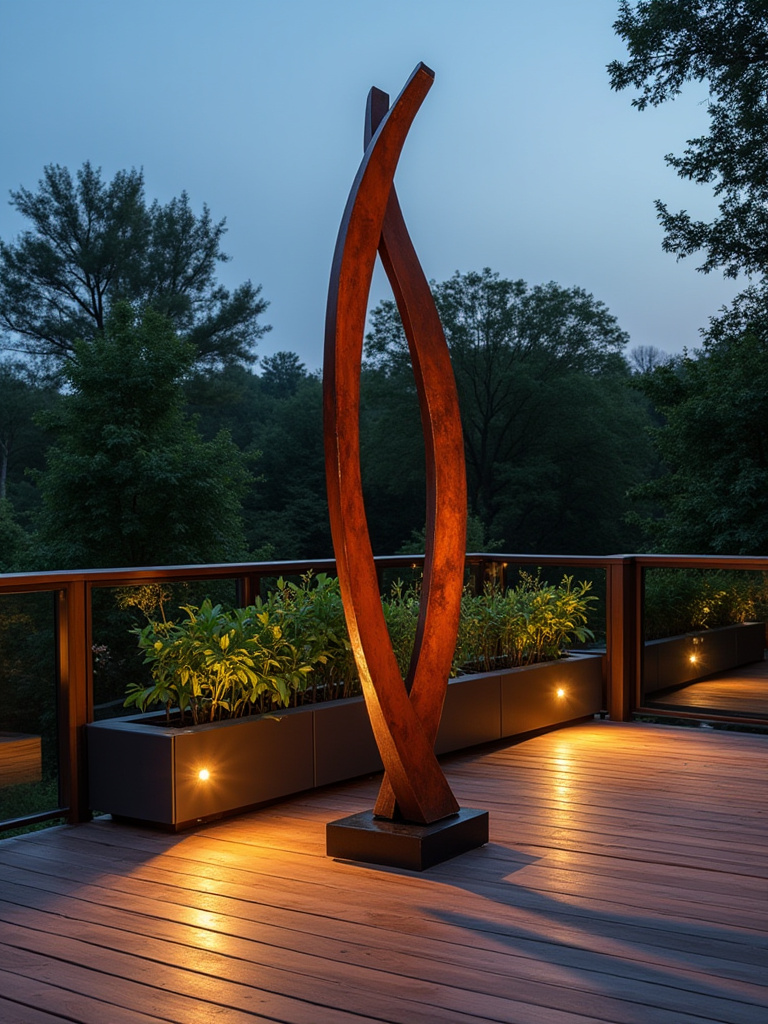
The key is to choose materials that can withstand the elements. Corten steel, which develops a stable, rust-like patina, is a great option. Stone, ceramic, and even marine-grade resin are also excellent choices. By incorporating a piece of art that tells a story or reflects your personality, you elevate your deck from a decorated space to a curated one. It becomes a place that is uniquely and authentically yours.
Art engages the eye, but to create a truly immersive sanctuary, we need to engage the other senses as well.
15. Enhance Mood with Wind Chimes or a Small Water Feature
In our noisy, overstimulated world, the gentle, natural sounds of a wind chime or trickling water can be incredibly restorative. This is a core concept of biophilic design: our innate need to connect with nature for our own well-being. A beautifully tuned wind chime made from bamboo or recycled glass can create a peaceful, meditative soundscape that helps to mask less desirable noises like traffic. It’s a simple addition that can have a profound impact on the atmosphere of your space.
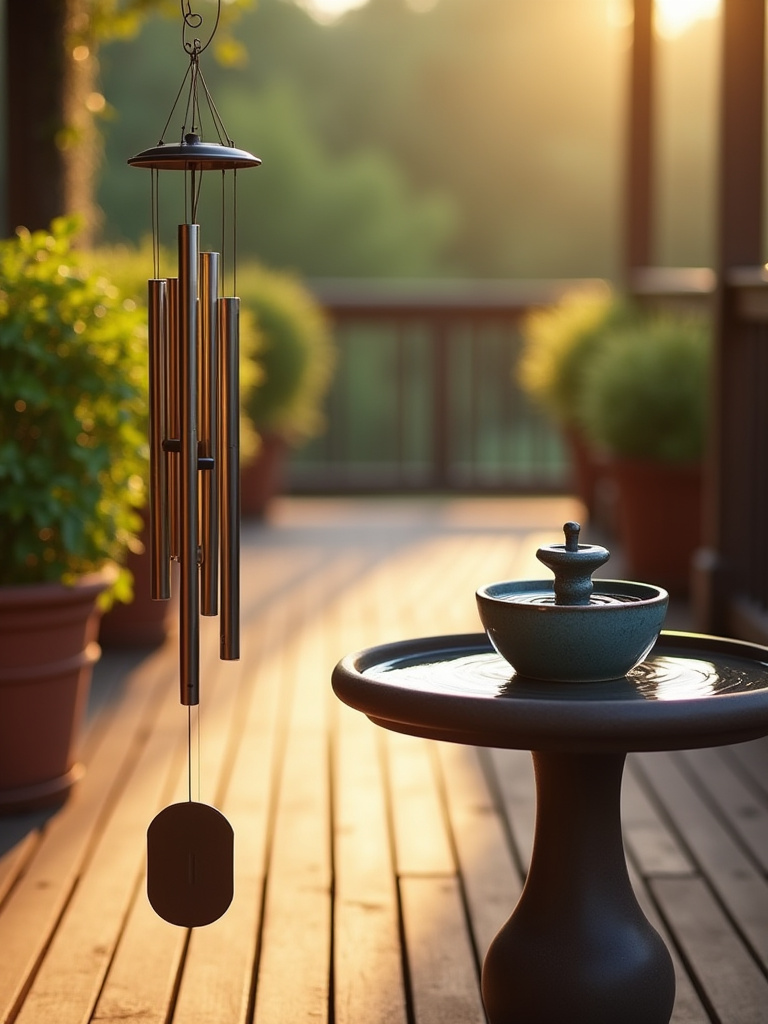
A small, self-contained water feature can have a similar effect. The sight and sound of moving water is universally calming. You don’t need a massive fountain; a small tabletop or wall-mounted unit is often enough to provide the soothing sound you’re after. Look for solar-powered options to eliminate the need for wiring and electricity. A solar-powered pump will circulate the water whenever the sun is out, creating a beautiful, energy-free sensory experience. These small touches transform your deck from a place you sit to a place you experience.
As we continue to layer in these personal touches, let’s not forget the most important living element: the plants.
Styling, Lighting & Decorative Enhancements (Part 2)
We’ve set the mood and added personal flair. Now, let’s focus on the final layers of styling that truly bring your sustainable deck to life. This is where we perfect the greenery and prepare the space for one of its most enjoyable uses: sharing a meal with people you love.
16. Arrange Plants in Varying Heights and Textures for Visual Interest
A collection of pots all the same size creates a flat, uninspired look. The secret to lush, professional-looking container gardens is to think like a landscape designer and create layers. Use a combination of tall, medium, and low plants to create a sense of depth and visual interest. For your “thriller” (the tall plant), choose a native ornamental grass. For your “filler” (the mid-level plant), use a flowering perennial that supports local pollinators. For your “spiller” (the cascading plant), pick a hardy trailing vine.
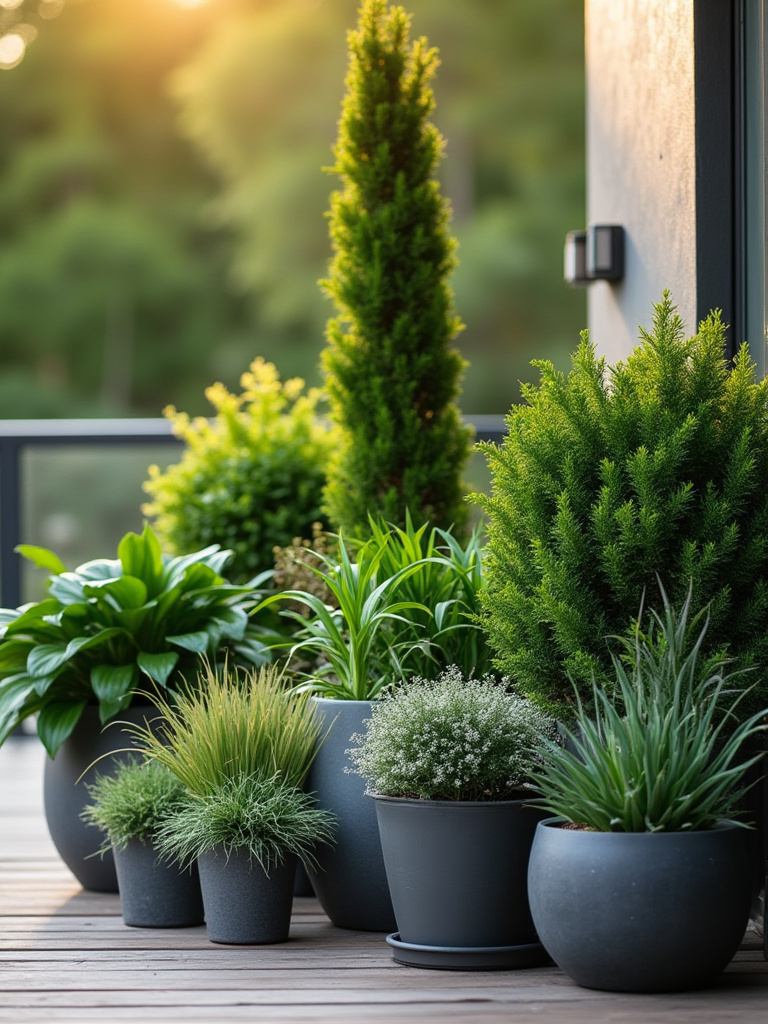
Focus on native, drought-tolerant species whenever possible. These plants are adapted to your local climate, which means they’ll require less water, less fertilizer, and less fuss than exotic annuals. They also provide essential food and habitat for local wildlife. Mix up the textures, too. The bold, waxy leaves of one plant next to the delicate, feathery fronds of another creates a beautiful contrast. This isn’t just decorating; it’s ecological restoration on a micro-scale, creating a space that is beautiful for you and beneficial for the planet.
This vibrant, living backdrop is the perfect setting for enjoying a meal outdoors.
17. Set the Table for Al Fresco Dining with Durable Dinnerware
Let’s make a pact to end the tyranny of the paper plate. There is absolutely no reason to create a mountain of single-use trash every time you eat outside. Investing in a set of durable, reusable outdoor dinnerware is an easy and impactful sustainable swap. Modern melamine is a fantastic option; it’s lightweight, nearly indestructible, and comes in gorgeous designs that look just like ceramic. Another wonderful, earth-friendly choice is dinnerware made from bamboo fiber, which is a highly renewable resource.
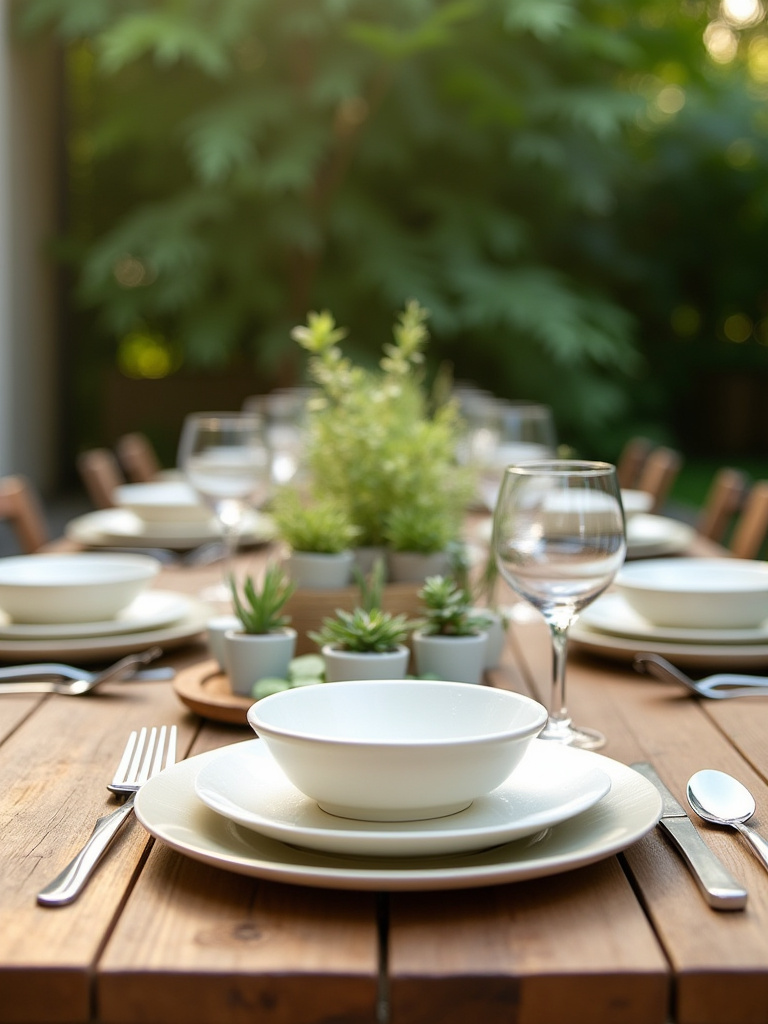
Having a dedicated set of outdoor dishes makes even a simple weeknight meal feel like a special occasion. It elevates the experience and encourages you to slow down and savor your food and your surroundings. Store them in a basket or a dedicated drawer near your patio door for easy access. This is a small investment that will pay off in years of beautiful, waste-free meals.
Now that your deck is beautifully styled and fully functional, let’s talk about how to keep it that way for the long haul.
Maintenance, Safety & Advanced Touches (Part 1)
A beautiful deck is only as good as the care it receives. Creating a sustainable oasis isn’t a one-time project; it’s an ongoing relationship. These next steps are about protecting your investment—both in time and money—and integrating smart technology that makes sustainable living even easier and more enjoyable.
18. Protect Your Deck with Regular Cleaning and Sealing
All the sustainable choices we’ve made will be for naught if the deck itself rots away prematurely. Regular maintenance is a non-negotiable part of the sustainability equation. At least once a year, you need to give your deck a thorough cleaning. But please, step away from the harsh chemical cleaners. A simple solution of oxygen bleach (which breaks down into harmless water and oxygen) and water is incredibly effective at removing mold, mildew, and grime without poisoning your soil or harming the plants below. A gentle scrub is all you need.
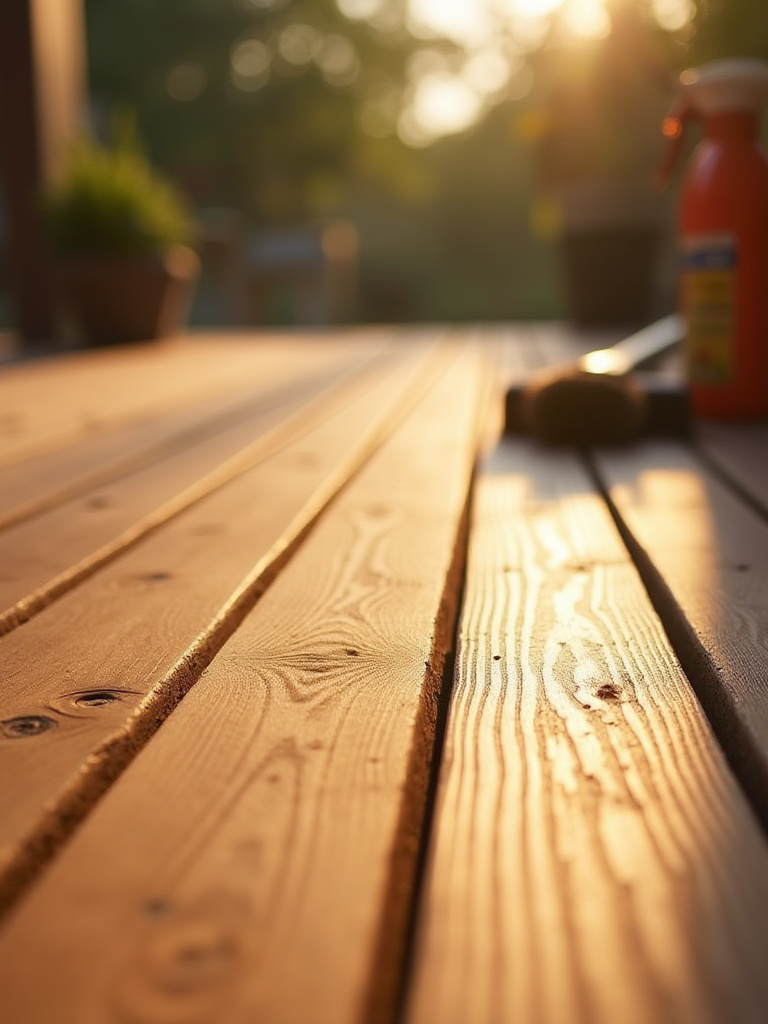
When it’s time to reseal your deck (every 1-3 years, depending on your climate), choosing the right product is critical. Look for low-VOC or zero-VOC (Volatile Organic Compound) sealants. VOCs are harmful chemicals that off-gas into the atmosphere, contributing to air pollution and potentially causing respiratory issues. Water-based stains and sealers typically have much lower VOC levels than their oil-based counterparts. Protecting your wood doesn’t have to come at the expense of clean air.
This commitment to upkeep extends beyond the surface to the essential safety features of your deck.
19. Prioritize Safety with Secure Railings and Non-Slip Surfaces
A deck isn’t a sanctuary if it isn’t safe. As part of your annual cleaning routine, make a habit of thoroughly checking your railings. Grab each post and give it a firm shake. Inspect all the connections and fasteners. A loose railing is a serious hazard waiting to happen. Maintaining the safety and integrity of your deck ensures it can be enjoyed for its maximum lifespan, preventing the waste and resource consumption of a premature replacement.
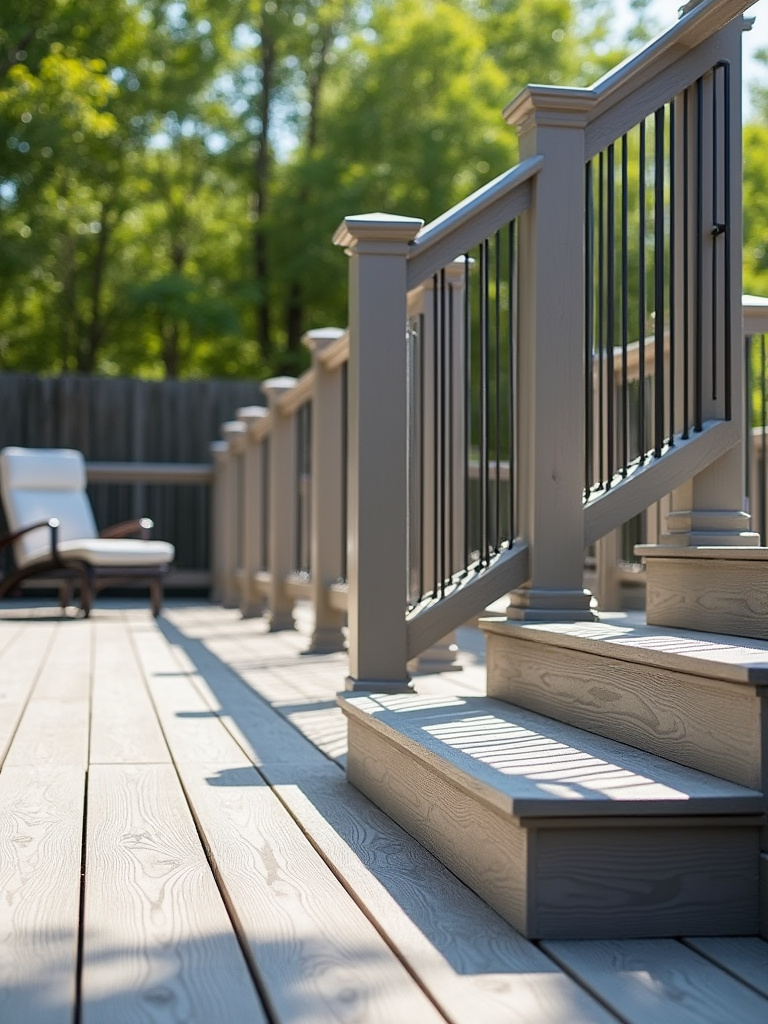
If you have wooden stairs that get slippery when wet, you don’t need to replace them. You can add texture and grip with non-slip treads made from recycled rubber or by applying a coat of clear sealant mixed with a sand-like additive. These are simple, low-impact fixes that can prevent a serious injury. A safe deck is a sustainable deck because it’s a deck that will continue to serve you and your family for years to come.
As we look to the future, we can even integrate technology to help us be better stewards of our space.
20. Incorporate Smart Home Technology for Automated Comfort
I know “smart tech” can sometimes feel like a gimmick, but when used thoughtfully, it can be a powerful tool for sustainability. Think about your outdoor lighting. By connecting your low-voltage LED system to a smart plug or switch, you can program your lights to turn on at sunset and off at a set time, say 11 p.m. This ensures you never accidentally leave them on all night, wasting energy. It’s effortless conservation.
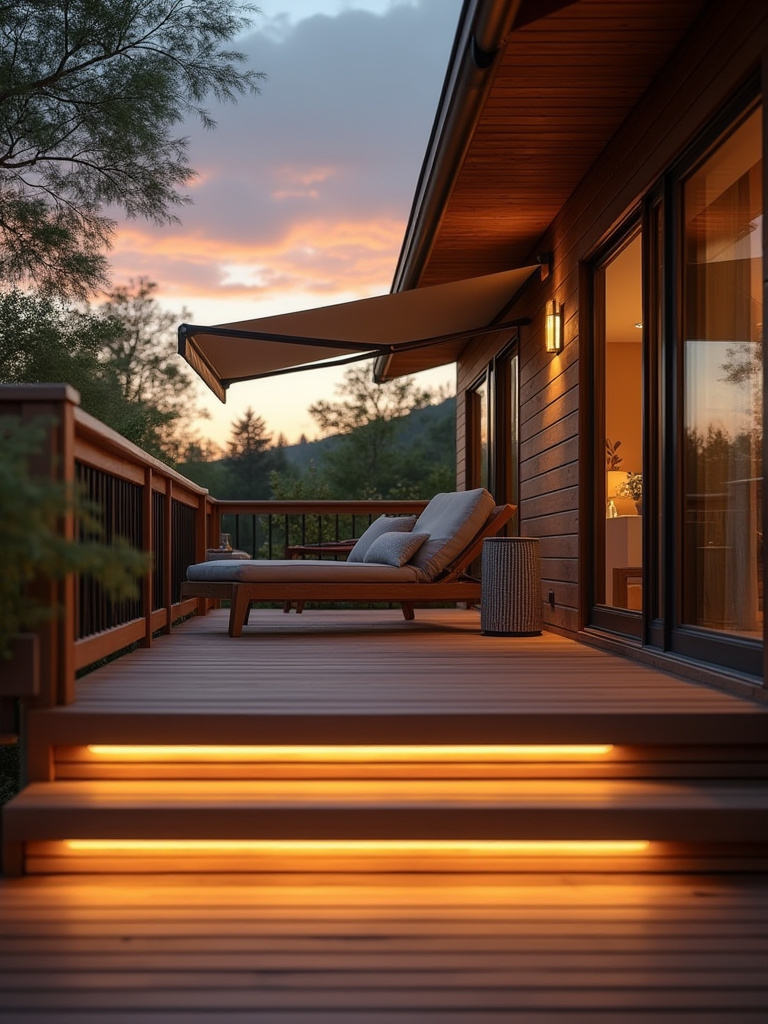
The same principle applies to electric infrared heaters. A smart outdoor plug allows you to turn the heater on from your phone a few minutes before you go outside, so it’s warm when you arrive, and you can easily turn it off when you come back in. This prevents you from running a heater for hours unnecessarily. The goal of smart tech shouldn’t be just about convenience; it should be about giving you precise control over your energy consumption, making it easier than ever to use only what you need.
This mindset of adaptability and forward-thinking applies not just to tech, but to the entire way we approach decorating through the seasons.
21. Design for Year-Round Enjoyment with Seasonal Decor Swaps
A truly sustainable deck is one that gets used and loved all year long. To achieve this, think of your decor not as static, but as a rotating “capsule collection.” Instead of buying new trendy items every summer, invest in a timeless set of high-quality foundation pieces and then create small, curated kits of accessories for each season. For summer, this might be lightweight linen pillows and a basket of citronella candles. In the fall, you can swap those for chunky knit throws, weatherproof flannel-patterned cushions, and some solar-powered lanterns.
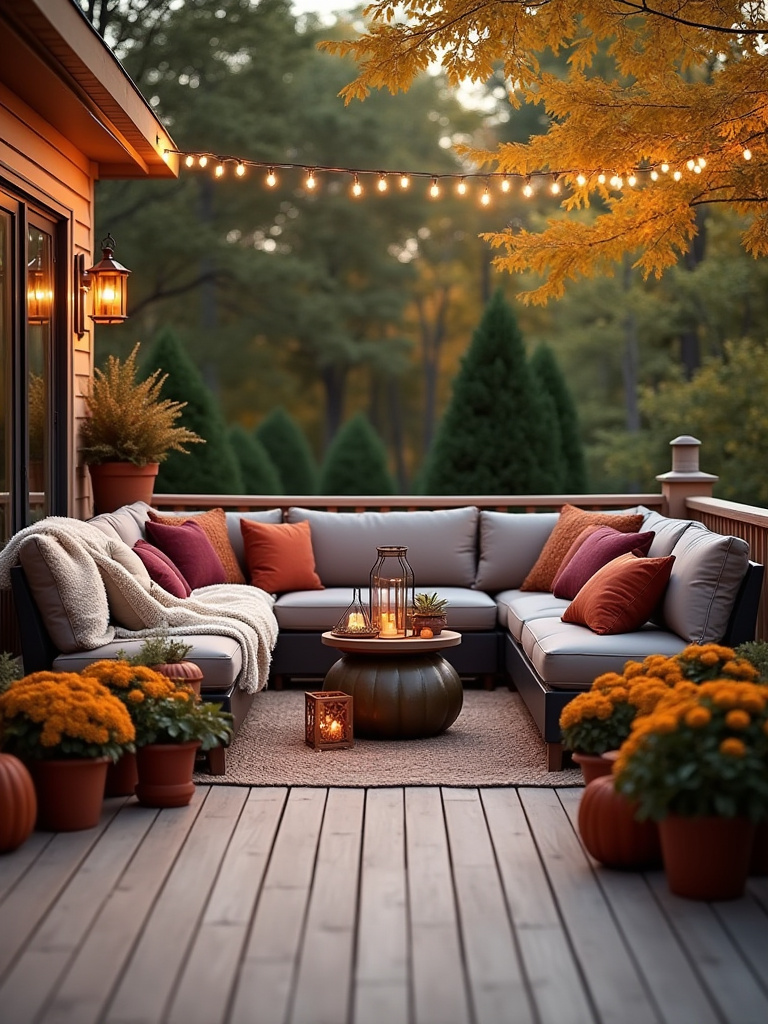
Store your off-season kit in a dedicated weatherproof box. This approach does two things. First, it prevents decor fatigue and keeps your space feeling fresh and exciting, which encourages you to use it more often. Second, it combats the consumerist urge to constantly buy new things. By creating a beautiful, rotating collection that you love and care for, you reduce waste and find joy in what you already own.
The key to making these seasonal swaps work is protecting your items when they’re not in use.
Maintenance, Safety & Advanced Touches (Part 2)
We’re at the finish line. The final piece of the puzzle is all about preservation. By taking one last crucial step, you ensure that all the thoughtful, sustainable choices you’ve made are protected, allowing your beautiful deck decor to last for many seasons and creating a truly enduring outdoor oasis.
22. Prepare for Inclement Weather with Protective Covers
I cannot stress this enough: a high-quality protective cover is one of the best investments you can make. Leaving your beautiful, sustainable furniture exposed to the harsh realities of winter—snow, ice, freezing rain—is a recipe for premature aging and damage. A good cover, made from durable, breathable fabric, shields your furniture from moisture, UV rays, and debris. This simple act can easily double the lifespan of your cushions and significantly extend the life of your furniture’s frame and finish.
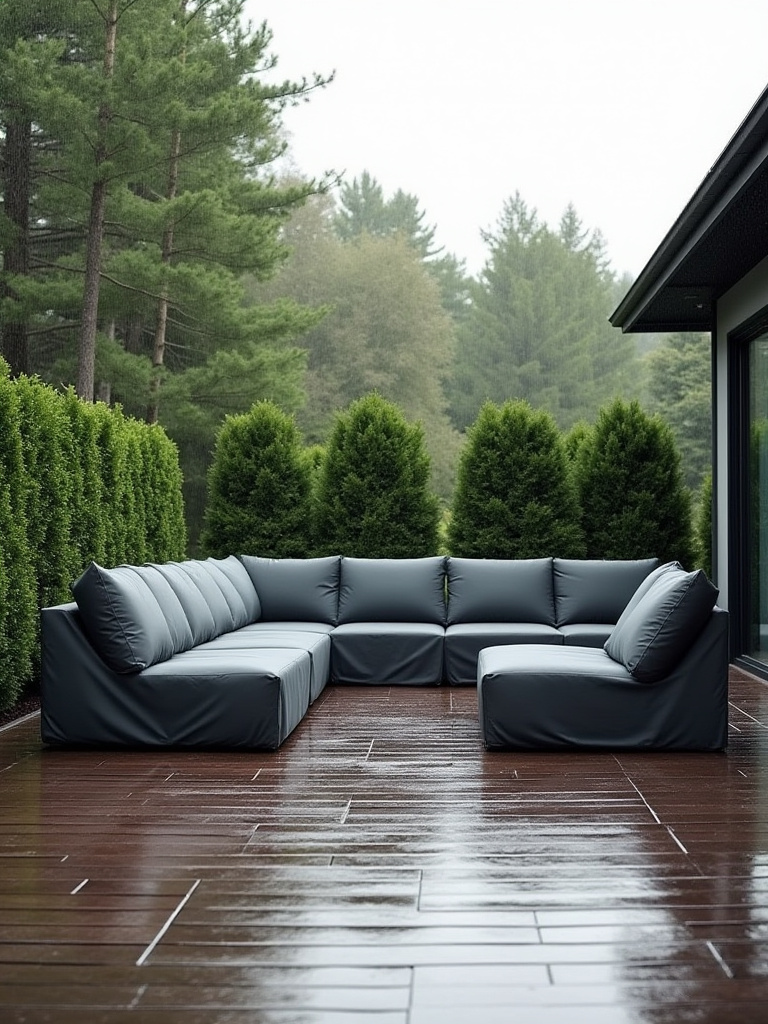
Look for covers made from recycled polyester and ensure they have vents to allow air to circulate, preventing mold and mildew growth. Securing them properly is also key. This isn’t just about protecting your belongings; it’s about reducing waste. Every season you can add to the life of your furniture is one less piece of furniture in a landfill. Think of it as putting your deck to bed for the winter so that it’s ready and waiting for you, in perfect condition, come spring.
Conclusion
There you have it. Creating a stunning, comfortable, and truly sustainable deck isn’t about sacrifice or settling for a less stylish space. It’s about being intentional. It’s about seeing the connection between a healthy planet and a healthy home, and understanding that beautiful design and environmental responsibility are not mutually exclusive—they’re deeply intertwined. Every choice, from the sealant on your deck boards to the fabric of your throw pillows, is an opportunity to create a space that nurtures you and gives back to the world around it.
Don’t feel like you have to do everything at once. Start with one thing. Maybe this year, you commit to investing in long-lasting furniture. Or perhaps you start by swapping out your annual flowers for native perennials. Every small, conscious choice is a step in the right direction. You have the power to create an outdoor sanctuary that reflects your values, delights your senses, and serves as a beautiful testament to the idea that the most luxurious spaces are the ones that let us live in harmony with nature.
